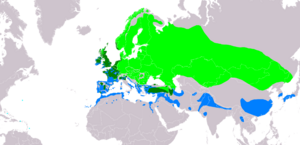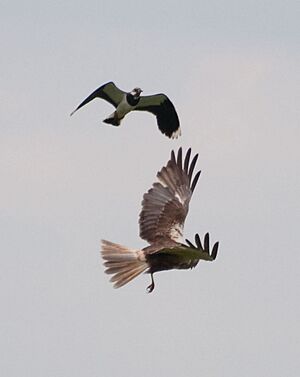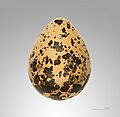Northern lapwing facts for kids
Quick facts for kids Northern lapwing |
|
|---|---|
 |
|
| Conservation status | |
| Scientific classification | |
 |
|
| Northern lapwing distribution. Light green: summer visitor. Dark green: resident. Blue: winter visitor. | |
| Synonyms | |
|
The northern lapwing (Vanellus vanellus) is a cool bird known by many names! People also call it the peewit or pewit, tuit or tewit, and green plover. In places like Ireland and Great Britain, it's often just called a lapwing or pyewipe.
This bird is part of the lapwing family. You can find it commonly across many parts of Europe and Asia.
Contents
Understanding the Northern Lapwing's Name
A long time ago, in 1758, a Swedish scientist named Carl Linnaeus gave the northern lapwing its first scientific name, Tringa vanellus. Later, another scientist, Mathurin Jacques Brisson, put it in the group of birds called Vanellus. This is where all lapwings belong today.
The scientific name Vanellus comes from a Latin word. It means "little fan" and refers to how the bird flaps its wings.
The name "lapwing" might come from the sound its wings make when it flies. It could also be because of how it flies, which looks a bit wobbly. Another idea is that it "laps" or draws predators away from its nest by pretending to have a broken wing.
The names "peewit" or "tew-it" are fun! They sound just like the bird's call. This is called an onomatopoeic name.
What Does a Northern Lapwing Look Like?
The northern lapwing is about 28–33 cm (11–13 in) long. That's about the length of a ruler! Its wings can spread out to 67–87 cm (26–34 in) wide. It weighs between 128–330 g (4.5–11.6 oz), which is like a few small apples.
This bird has round wings and a cool crest of feathers on its head. It also has the shortest legs of all the lapwings. Its body is mostly black and white, but its back has a pretty green shine to it.
Male lapwings have a long crest and a black head, throat, and chest. This black color stands out against their white faces. Female and young birds have shorter crests. Their head markings are not as strong, but they look quite similar to the males.
Northern lapwings are very noisy during their breeding season. Males make constant calls as they perform their tumbling display flights. Their usual call sounds like a loud, sharp "pee-wit!" This is why they are often called "peewits." When showing off, males often make a wheezy "pee-wit, wit wit, eeze wit" sound. They can also make squeaking or mewing noises.
Northern Lapwing Behavior and Life
Northern lapwings are birds that travel a lot. They are highly migratory over most of their wide home range. They fly south for winter to places like North Africa, India, and parts of China. They usually migrate during the day, often in huge groups. Some lapwings that live in western Europe stay in the same place all year.

This bird is a wader, meaning it likes shallow water and wet ground. It builds its nests on farms and in other places with short plants. They lay 3 to 4 eggs in a small dip on the ground. The parents are very loud and brave when protecting their nest and young. They will even chase away large animals like horses and cattle!
In winter, northern lapwings gather in huge flocks. You can see them in open fields, especially on farms and muddy areas near water.
They mostly eat insects and other small creatures without backbones. Lapwings often feed with other birds like golden plovers and black-headed gulls. The gulls sometimes steal food from the lapwings and plovers. But, they also help protect them from other predators. Like golden plovers, lapwings prefer to find food at night when the moon is out.
Why Northern Lapwing Numbers Are Declining
Sadly, the number of northern lapwings has been going down. Surveys in England and Wales showed a big drop between 1987 and 1998. Since 2009, the northern lapwing has been on the "red list" for conservation in the United Kingdom. This means they are at high risk.
Their numbers have been hurt by modern farming methods. In flat areas, this includes losing grassy fields and changing land into farms or better pastures. Also, farmers now plant crops in autumn instead of spring. This means less good nesting spots for the birds. In hilly areas, more grazing animals might be a problem.
Some groups are trying to help. They offer money to farmers to create good homes for lapwings. For example, farmers can leave unplanted areas of land. These plots give the birds safe places to nest. They are kept without fertilizers or bug sprays.
Besides changes in farming, predators also eat lapwing nests and chicks. Scientists use tiny radio tags to track chicks. This helps them learn when and what kind of animals are eating the chicks. Mammals seem to be the biggest problem, both day and night.
In Armenia, lapwing numbers are also dropping. This is likely due to more intense farming and hunting. In the Middle East, too many northern lapwings are hunted during their winter travels. Photos show many lapwings, along with other traveling birds, being killed for sport. This is not sustainable and hurts their populations.
Northern Lapwing in Culture and History
Plover's Eggs: A Special Treat
"Plover's eggs" used to be a very expensive and fancy food in Europe a long time ago. They were mentioned in old books about rich British society.
In the Netherlands, there's a special tradition. People have a friendly competition to find the first peewit egg of the year. This is very popular in the province of Friesland. For a while, collecting these eggs was not allowed by the European Union. But Friesland was given a special pass for cultural reasons. This pass was later removed.
Now, people can look for peewit eggs between March 1st and April 9th. But they are not allowed to take the eggs anymore. Over the last 100 years, the first egg has been found earlier and earlier each year. This is thought to be because of more fertilizers being used and climate change. Both of these make grass grow earlier, which is needed for the birds to lay eggs.
Ireland's National Bird
The northern lapwing was chosen as the Republic of Ireland's national bird in 1990. In the Irish language, it's called pilibín. This means "little Philip." Some people think this name refers to Philip II of Spain (King of Ireland from 1554–58). He was known for often wearing a feather in his cap.
Lapwings in Old Stories
In old stories, like the Roman poet Ovid's Metamorphoses, a bird called a "lapwing" is mentioned. It's likely the northern lapwing. In one story, a character named Tereus turns into a bird. Ovid probably meant the hoopoe, which has a crest like a crown and a sharp beak.
Images for kids
-
In some years, lapwings gather in large groups after breeding. This picture shows part of a flock of about 3,000 birds in Ystad on September 24, 2017.






